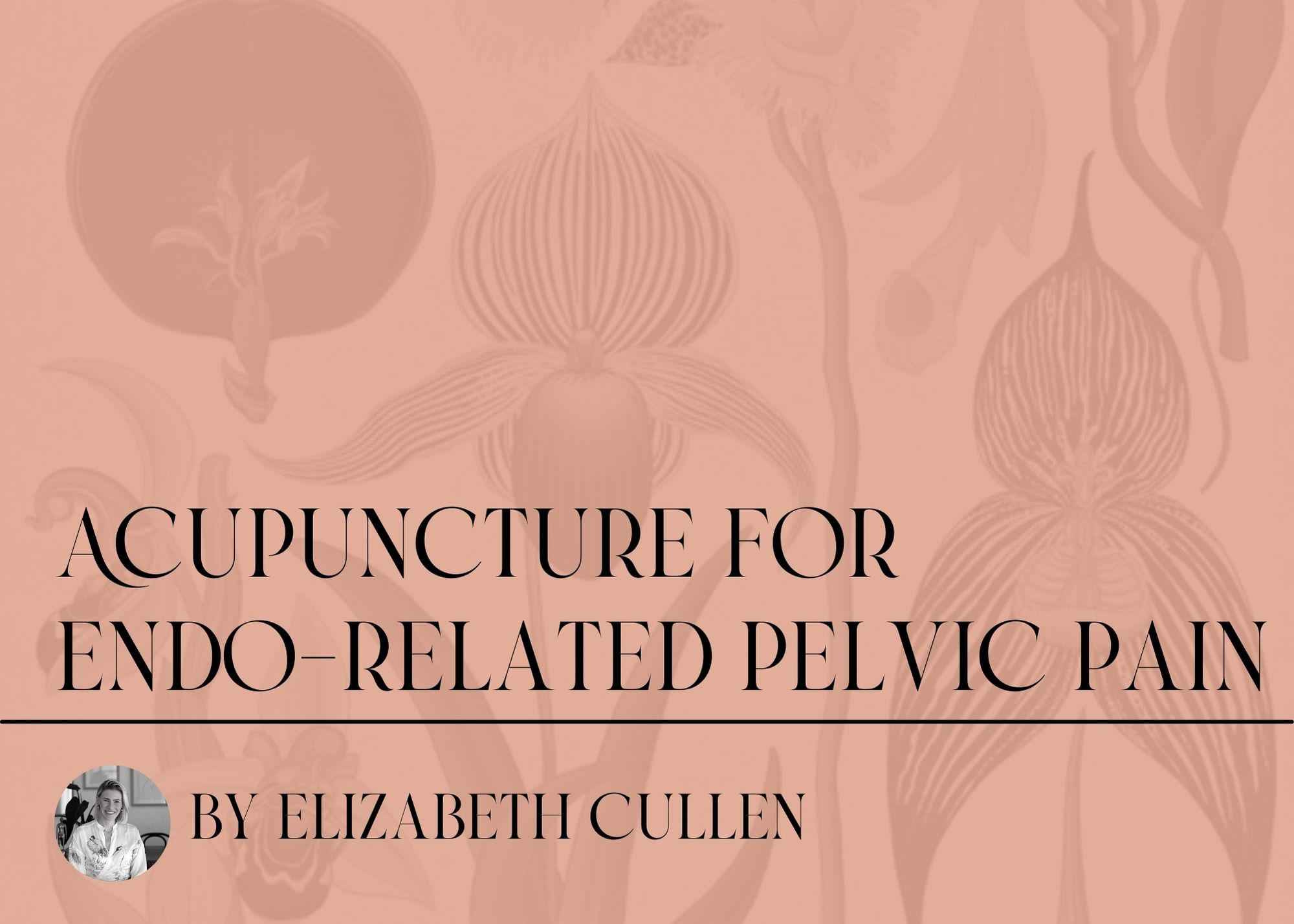The Dao Does ~ How Acupuncture Reduces Endometriosis related Pelvic Pain
Acupuncture for Endometriosis related Pelvic Pain
The Complexities of Endometriosis
Endometriosis is a complex condition that affects 1 in 7 women, girls and those assigned female at birth and is considered a leading cause of pelvic pain (1).
Managing Endometriosis is not a one-size-fits-all approach and current treatments including Laparoscopic surgery, and pharmaceutical and hormonal treatments do not always provide symptom relief (2). Treating Endometriosis and associated symptoms will differ for each individual and ideal care requires a multi-disciplinary approach with evidence-based treatments and patient-centred care.
Previously in The Dao Does journal, Clarice Berry outlines what Endometriosis is, the symptoms associated, the causes and how Traditional Chinese Medicine treats Endometriosis.
You can read this post here:
How Chinese Medicine & Acupuncture Support Endometriosis ~
Managing Endometriosis related Pelvic Pain
Pelvic Pain is a significant and common symptom associated with Endometriosis. Acupuncture treatment can be considered a complementary treatment to consider as part of a multi-disciplinary approach when it comes to managing endometriosis-related Pelvic Pain.
Acupuncture decreases pelvic pain through physiologic mechanisms which reduces pain in the local pelvic region as well as the body overall.
This occurs through the insertion of specific Acupuncture points which stimulate nerve receptors and neural pathways to support the pain deactivation mechanism via the Cerebral Cortex. This, in turn, activates the body’s release of Opioids as well as regulates the autonomic nervous system and central nervous system resulting in pain relief.
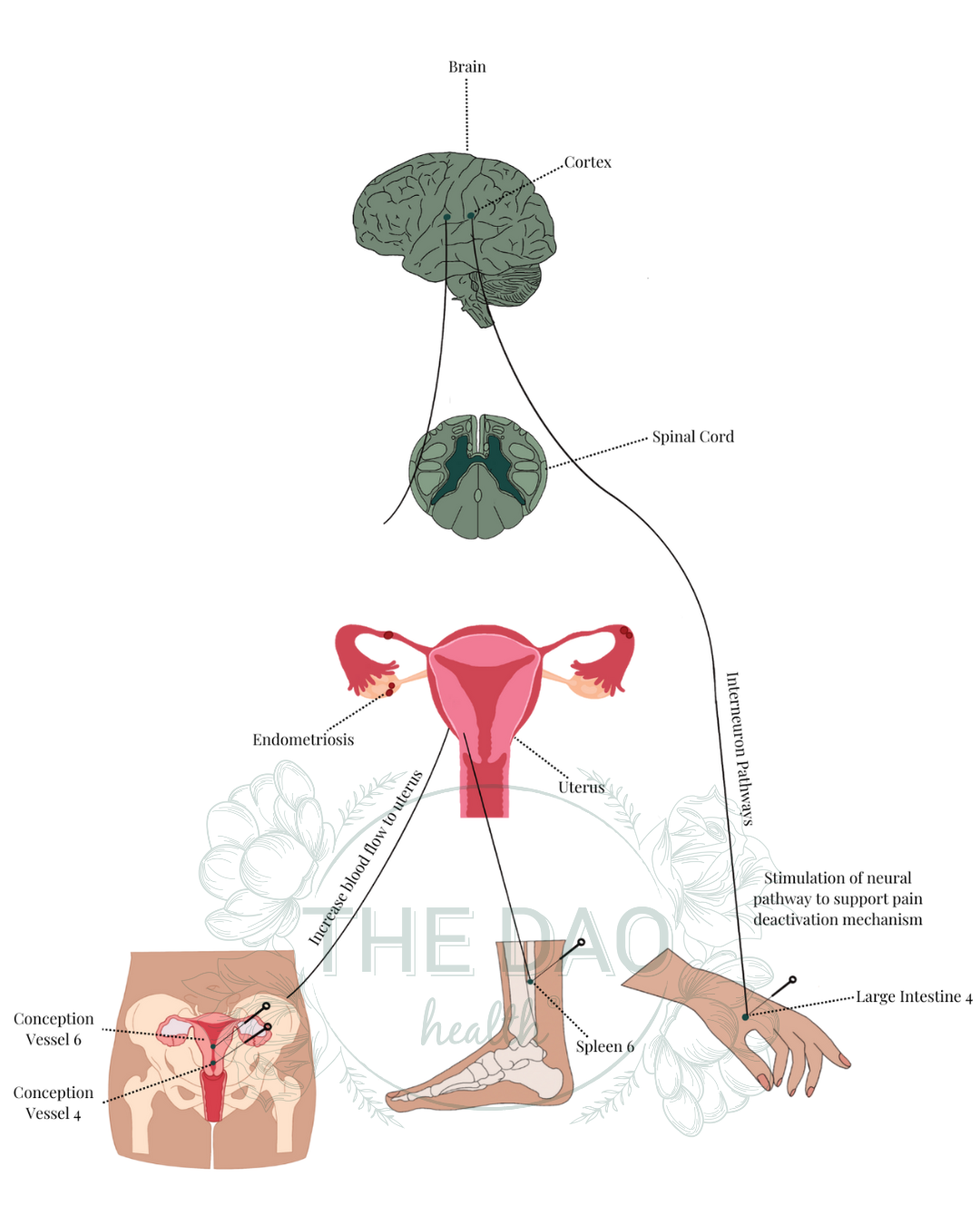
In the above diagram, you can see two acupuncture points used to reduce pain relief distally, Spleen 6* and Large Intestine 4.
*Please note, that Spleen 6 is contraindicated in pregnancy and should not be used in treatment for patients trying to conceive from Ovulation in the Luteal Phase or pregnancy to 36 weeks.
The local points on the Pelvis include Conception Vessel 6, Conception Vessel 4, Zi Gong and St27 and these are a number of examples of Acupuncture points that increase blood flow to the Uterus which supports to reduce symptoms of pelvic pain in addition to other Endometriosis symptoms such as Dysmenorrhea, otherwise known as period pain and cramping.
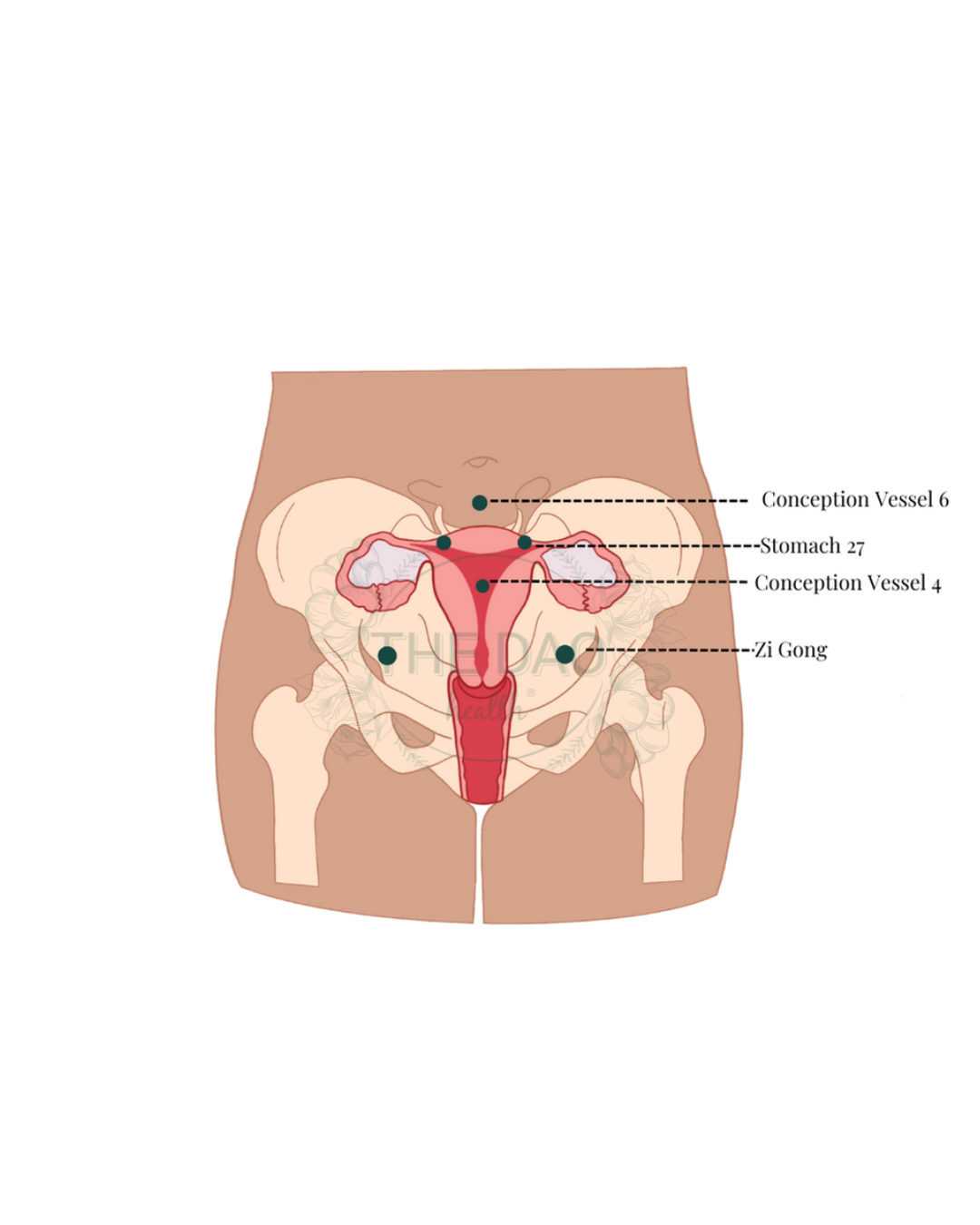
What does the research tell us?
The research continues to support that Acupuncture is a clinically relevant option to consider for the treatment of Endometriosis and pelvic pain (2).
A 2021 randomised controlled feasibility study by Mike Armour et al. looked at determining the acceptability and feasibility of Acupuncture for the treatment of endometriosis–related chronic pelvic pain.
The intervention group received Acupuncture twice a week for eight weeks with a set needle protocol. The control group received usual care alone which involved no additional support or treatment than the participant was receiving before the trial. The Dao Health and I were involved in this study as one of the clinics that provided treatment.
The results concluded that there was a 48% decrease in pelvic pain from baseline to the end of the trial in the Acupuncture group compared to the usual care-alone group and a 20% decrease in overall body pain (3).
Acupuncture as a complementary treatment to consider for Endometriosis related pain is further supported by Y Xu et al. systematic review and meta-analysis study from 2017 which researched the effects of acupuncture for the treatment of Endometriosis related pain. The study’s outcomes resulted in Acupuncture providing a significant reduction in Endometriosis related pain, primary pain levels and a decrease in CA-125 levels compared to the specific control groups (4).
Most recently in October 2023, a systematic review and meta-analysis by Nora Giese, Ky Kyung Kwon and Mike Armour looked at Acupuncture for Endometriosis and examined the effectiveness of acupuncture on pain and quality of life in people with Endometriosis. The study concluded that Acupuncture treatment for Endometriosis demonstrated clinically relevant improvements in pelvic pain and should be considered as a potential treatment intervention (2).
A Clinical Reality
When it comes to considering Acupuncture treatment to manage Endometriosis and related Pelvic Pain, it is important to have a clear expectation of the amount of Acupuncture that will be required for managing symptoms. From a biomedical perspective, due to Acupuncture having a physiological effect on the body, it should be considered to have a dose. Similar to checking a medication’s dose before use for effective menstrual pain relief, Acupuncture can also be viewed as having a dose. This means that for Acupuncture to have an effect on the body a series of treatments is required to see whether Acupuncture is effective or not for a patient individually.
From clinical experience, I do not expect for a patient to have a significant change in symptoms after one Acupuncture treatment and discuss with a new patient that a minimum of 8-12 treatments over three months is recommended to manage Endometriosis.
As you can see in the below table, Acupuncture treatments begin at a high frequency and then reduce to maintenance. Interestingly, Acupuncture treatments are timed with the menstrual cycle or cyclical pain and I recommend treatment 5-10 days before expected peak pain. In a time of an Endo flare-up, treatment increases again.
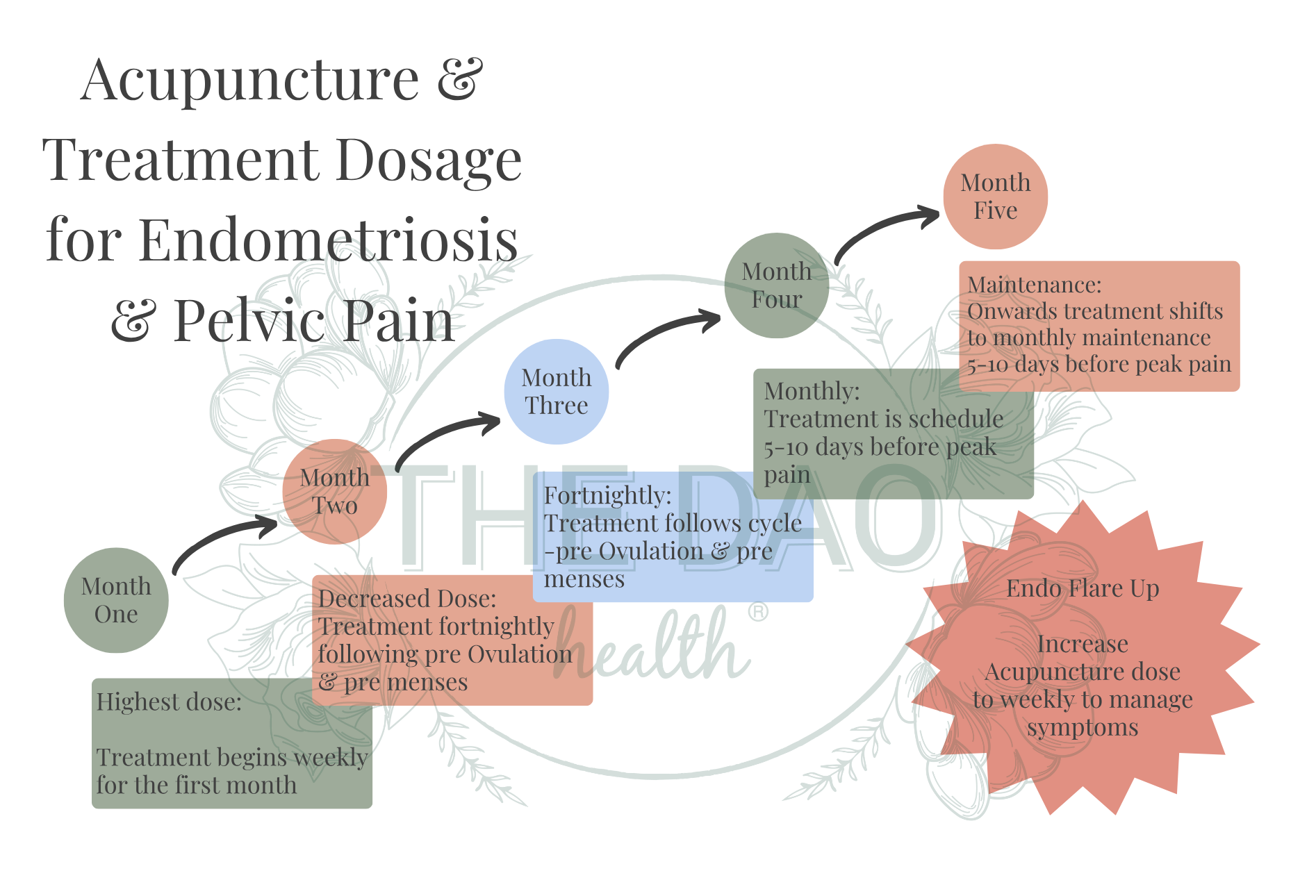
An integrative model of care
For patients considering an integrative model of care, it is important to build the team around you with medical professionals and health practitioners who listen to you and your symptoms.
From my clinical experience, I find an integrative model of care is ideal for Chronic Pelvic Pain and Endometriosis. This includes a Pelvic Floor Physiotherapist who can assess your pelvic floor internally and externally. In patients who receive treatment from both allied therapies of pelvic floor physiotherapy and acupuncture, anecdotally I find faster improvements with patients with more positive outcomes.
I would like to also discuss the barriers to an integrative model of care including accessibility, the time dedicated to appointments and the economic burden that comes with a diagnosis of Endometriosis which in 2017 was estimated as $30, 900 per person. It is also important to note that costs increase with pain severity, with costs for people with severe pain being six times higher compared to people with minimal pain (5). Hopefully, in the near future we see an improvement in these barriers through further funding and government support.
I have included what an integrative patient-centred model of care can look like for patients when looking to build their care team around them.
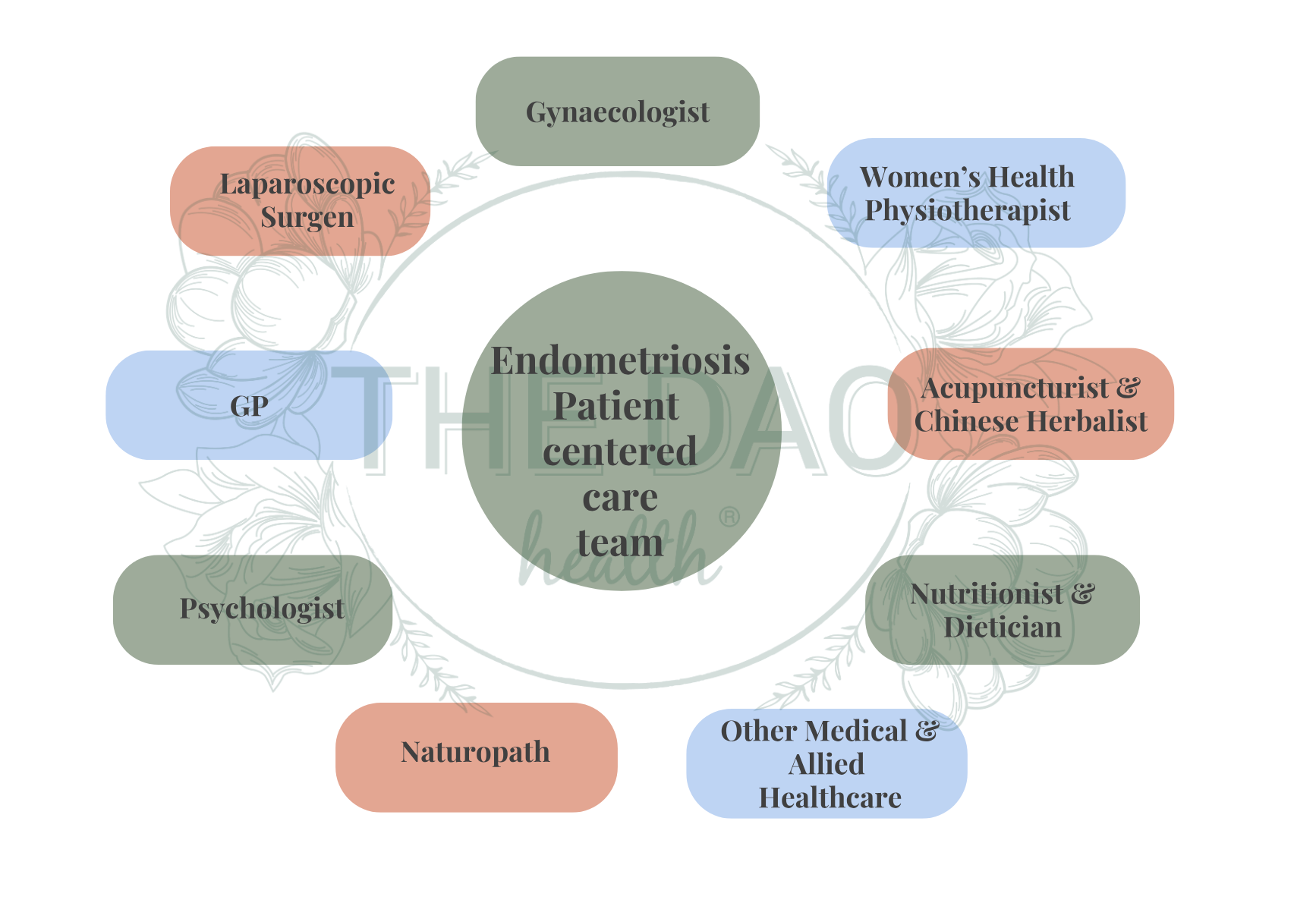
Investigating Pelvic Pain
On a final note, persistent pelvic pain affects 10-20% of women and should always be investigated. Quoted from Dr Amani Harris, advanced Endoscopic ( Laparoscopic and robotic ) gynaecological surgeon and obstetrician summarises this well saying “Not all Pelvic Pain is Endometriosis, but Pelvic Pain should be taken seriously, assessed and treated”.
You can read this interview from Jean Hailes Women’s Health Week 2023 Journal Series here ~ The Progress on Endometriosis
For further resources, please see the below episodes on the Integrating Chinese Medicine podcast:
~ The ABC of Acupuncture Bioscience CBD Oil with Mike Armour
~ Endometriosis & Adenomyosis, Empowering the Conversation with Dr Amani Harris
~
By Elizabeth Cullen (BHlthSc (TCM), MWomHMed)
References
1.
Mooney SS, Grover SR. The persistent pelvic pain study: Factors that influence outcomes in women referred to a public hospital with chronic pelvic pain – A study protocol. Aust N Z J Obstet Gynaecol. 2021 Apr;61(2):E6-E11. doi: 10.1111/ajo.13289.
2.
Giese N, Kwon KK, Armour M. Acupuncture for endometriosis: A systematic review and meta – analysis, Integrative Medicine Research (2023), https://doi.org/10.1016/j.imr.2023.101003
3.
Armour M, Cave AE, Schabrun SM, Steiner GZ, Zhu X, Song J, Abbott J, Smith CA. Manual Acupuncture Plus Usual Care Versus Usual Care Alone in the Treatment of Endometriosis-Related Chronic Pelvic Pain: A Randomized Controlled Feasibility Study. J Altern Complement Med. 2021 Oct;27(10):841-849. doi: 10.1089/acm.2021.0004.
4. Xu Y, Zhao W, Li T, Zhao Y, Bu H, Song S. Effects of acupuncture for the treatment of endometriosis-related pain: A systematic review and meta-analysis. PLoS One. 2017 Oct 27;12(10):e0186616. doi: 10.1371/journal.pone.0186616.
5. Armour M, Lawson K, Wood A, Smith CA and Abbott J (2019) ‘The cost of illness and economic burden of endometriosis and chronic pelvic pain in Australia: A national online survey Doi: 10.1371/journal.pone.0223316.

